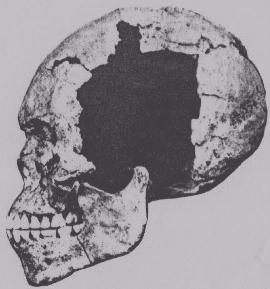
Link to research papers and articles: (http://wysinger.homestead.com/keita.html) |
Link to current African DNA research: (http://exploring-africa.blogspot.com/) |
Description of X-ray images of Royal Mummies in X-ray Atlas of the Royal Mummies
The standards for differentiating between racial or ethnic groups depends on the method used. In cephalometry and forensic science, there are some standards that have proven effective in practical usage. Because both dentofacial surgery and forensics require practical results, we can presume that ideology will play less of a role as compared to conventional anthropology. The latter has a long history of racial bias. The purpose of this study is to refute the argument that the Pharaohs did not conform to the "Negroid" phenotype, but not to support any biological basis of the concept of race.
Some standards that we will use in describing the x-ray diagrams (lateral view) of the royal mummies are now given:
WM Krogman (The Human Skeleton in Forensic Medicine)
Africoid: Rounded, projecting glabella; sagittal plateau; rounded forehead, prognathism; rounded occiput.
Caucasoid: Depressed glabella; rounded or arched sagittal contour; steep forehead; orthognathism; variable occiput.
S Rhine ("Non-metric skull racing")
Africoid: Slight depression of nasion; vertical zygomatic arches; prognathism; receding, vertical chin; straight mandibular edge.
Caucasoid: Depression of nasion; retreating zygomatic arches; orthognathism; prominent, bilobate chin; wavy mandibular edge.
RA Drummond ("A determination
of cephalometric norms for the Negro race"); TL Alexander
and HP Hitchcock ("Cephalometric standards for American
Negro children"); RJ Fonseca, WD Klein ("A
cephalometric evaluation of American Negro women"); CJ
Kowalski, CE Nasjlet, GF Walker (Differential diagnosis of adult
make black and white
populations); A Jacobson ("The craniofacial skeletal pattern
of the South African Negro")
Persons of African descent are distinguished by steep mandibular plane; sharp, vertical chin; protrusion of the incisors; prognathism; greater lower facial height but with less mid-facial height; upper mouth is more projecting than lower mouth (higher ANB angle).
Y'edyank and Iscan ("Craniofacial Growth and Evolution")
Mesolithic Nubians had low, sloping foreheads and robust features evolving into a globular cranium with high vault. The prominence of the orbital region was reduced by the Christian era and the occipital bun much less prominent. Flattening of the lambdoid and sagittal regions also became less pronounced. (Forensic analysis of the skull : craniofacial analysis, reconstruction, and identification. [editors Mehmet Yasar Iscan and Richard P. Helmer]. (New York, N.Y.: Wiley-Liss, 1993)

The male cranium above is from Wadi al-Halfa on the Sudan-Egypt border. Dating from the Mesolithic-Holocene period, it is typical of crania in Sudan and surrounding regions from that time frame. More recent Nubian crania from the Christian period have more rounded skulls without the sloping frontal bone. However, the vertical zygomatic arch, prominent glabella, sagittal plateau, and occipital bun (less pronounced) are retained. The cranium above has pronounced facial prognathism, but moderate dental protrusion. The chin is vertical with a angular mandible and very squat ramus. (Image from David Lee Greene and George Armelagos. The Wadi Halfa mesolithic population. (Amherst: University of Massachusetts, 1972)
The Royal Mummies
Late XVII and XVIII Dynasties
Queen Ahmes-Nefertary
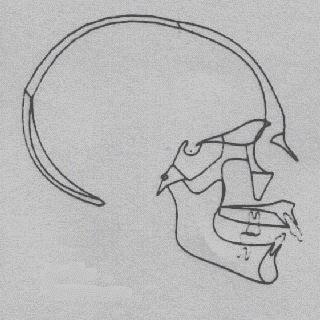
Father: Seqenenre Tao II or Kamose, Mother:
Queen Ahhotep I or Queen Ahhotep II
Strongly proclined incisors. Rounded forehead, sagittal
flattening; rounded occiput. Somewhat forward zygomatic arches;
pronounced alveolar prognathism. Steep mandible with squat ramus
and receding chin.
Amenhotep I
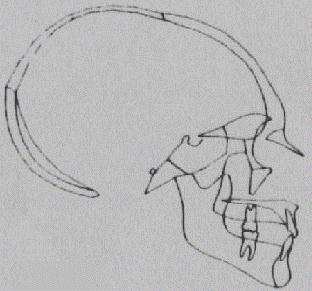
Father: Ahmose, Mother: Ahmes-Nefertary
Rounded glabella, sloping forehead, sagittal plateau, rounded
occiput. Zygomatic arches project forward. Moderate protrusion of
upper incisors and pronounced prognathism. Receding chin and
steeply inclined mandible.
Queen Meryetamon
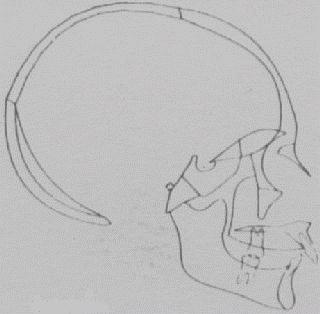
Father: Ahmose, Mother: Ahmes-Nefertary
Queen of Amenhotep I. Rounded occiput and forehead, sagittal
plateau. Glabella is weak, but there is sexual dimorphism in this
feature. Zygomatic arch is slightly forward. Pronounced
protrusion of incisors and high ANB causing overbite. Mandible is
moderately inclined and ramus is squat. Strong prognathism.
Thutmose I

Father: ?, Mother: Senisoneb
Globular skull with high vault; rounded forehead; sagittal
plateau; rounded, bulging occiput; weakly manifested glabella;
vertical zygomatic arches. Strongly proclined upper and lower
incisors; sharply receding chin and angled mandible. Squat ramus
and pronounced prognathism.
Thutmose II
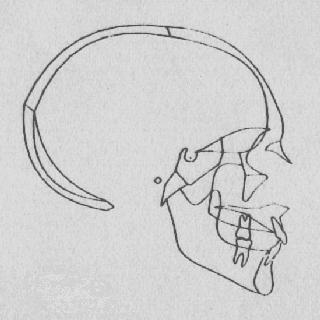
Father: Thutmose I, Mother: Queen Mutnofret
Rounded glabella and forehead; high vault with sagittal plateau.
Rounded occiput. Strongly proclined upper and lower incisors;
receding, vertical chin; highly angular mandible. Vertical
zygomatic arches and maxillary prognathism.

Thutmose II displays the globular cranium common among more
recent Nubians.
Tjuya
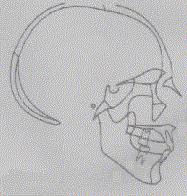
Mother of Queen Tiye
Rounded, prominent occipital bun; sagittal plateau; rounded
forehead. Vertical zygomatic arches; proclined upper and lower
incisors; strongly receding chin; steep mandible angle. Maxillary
prognathism.
"The Elder Lady"
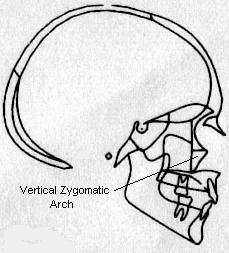
First identified as Queen Tiye
The occipital bun is reminiscent of Mesolithic Nubians (see
below). Sagittal plateau, rounded forehead with moderately
projecting glabella; globular cranium with high vault. Protrusion
of incisors, receding chin and steep mandible. Very vertical
zygomatic arches and pronounced maxillary prognathism.

The Elder Lady possesses an occipital bun comparable to
Mesolithic Nubians.
XVIV Dynasty
Seti I
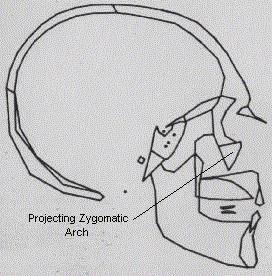
Father: Ramesses I, Mother: Queen Sitre
Projecting, arched glabella. Zygomatic arches are rather forward
giving prominent cheekbones. Very straight upper incisors;
receding chin; moderately steep mandible and broad ramus.
Sloping, rather flattened forehead. Occipital region is similar
to Pharaohs of XVIII Dynasty.
Ramesses II
Father: Seti I, Mother: Queen Mut-Tuy
Rounded forehead with sagittal plateau. Slight, rounded glabella.
Proclined upper incisors; receding chin with high ANB. Rather
long ramus with weak inclination of mandible. Orthognathous.
Merenptah
Father: Ramesses II, Mother: Queen Isis-nofret
I
Prominent, rounded glabella. Low, sloping forehead; sagittal
plateau; high ANB and overbite; receding chin. Rather long ramus
and slightly angular mandible like father, Ramesses II. Zygomatic
arches appear to project forward.
Siptah
Father: Merenptah, Seti II or Amenmesse,
Mother: Queen Tiaa
Prominent, rounded glabella. Low, sloping forehead and some
sagittal flattening. Vertical, receding chin and proclined upper
incisors. Strongly inclined mandible.
XX Dynasty
Ramesses IV
Father: Ramesses III, Mother: Queen Habadjilat
or Queen Isis
Bulging occipital bun. Rather low vault; rounded forehead with
pronounced glabella; vertical zygomatic arches; receding chin and
moderate protrusion of incisors. Angular mandible.
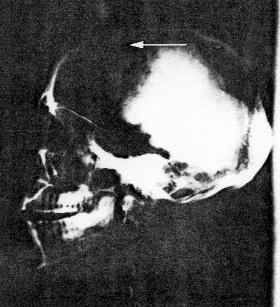
Notice Ramesses IV's occipital bun.
Ramesses V
Father: Ramesses IV or Ramesses III, Mother:
Queen Habadjilat or Queen Isis
Very prominent glabella. Protrusion of upper incisors; receding
chin and moderate inclination of mandible. Low, sloping forehead.
Flattening of the sagittal contour.

Ramesses V has a very pronounced glabella.
Other Royal Mummy X-rays
Queen Nodjme
Globular cranium, rounded forehead and occiput; sagittal plateau. Pronounced maxillary prognathism; blunt, receding chin and steep mandible.
Queen Sitkamos
Globular cranium, rounded forehead and occiput. Maxillary and mandibular prognathism; proclined upper incisors. Receding chin and angular mandible.
Queen Esemkhebe
Pronounced prognathism. Rounded forehead with flattish cranium and sagittal depression. rounded occiput. Pointed, receding chin.
Prince Ouabkhousenou
Globular cranium with occipital bun. Rounded forehead with prominent, rounded glabella. Strongly prognathous with receding chin and steep mandible.
Conclusions
SO Keita and others have stated that there was a strong trend toward hybridization from the early dynasties through the New Kingdom period. The predynastic and early dynastic Egyptians showed strong southern affinity.
The New Kingdom royal mummies suggest that the Pharaohs were continuing to intermix, both with people from the north and the south.
The late XVII Dynasty and XVIII Dynasty royal mummies display the strongest Nubian affinities. In terms of maxillary protrusion as measured by SNA, the mean value for these Pharaohs is 84.21 comparable to that of African Americans. They exceed the latter in terms of ANB and SN-M Plane, but are closer to Caucasians in regards to SNB. However, the ability of SNA and SNB to predict maxillary and mandibular protrusion respectively has been questioned. Some studies suggest that measuring prognathism from the Frankfort horizontal would produce more reliable results (See RM Ricketts, RJ Schulhof, L Bagha. Orientation-sella-nasion or Frankfort horizontal. Am J Orthod 1976 Jun;69(6):648-654; also JW Moore. Variation of the sella-nasion plane and its effect on SNA and SNB. J Oral Surg. 1976 Jan; 34(1): 24-26).
In regards to head shape, the late XVII and XVIII dynasty mummies are very close to Nubian samples intermediate between the Mesolithic and Christian periods. The zygomatic arches are almost always vertical or forward and not receding.
The XVIV Dynasty is higher in ANB and SN-M Plane than the XX Dynasty. Ramesses IV is the only one in these two dynasties with strong alveolar prognathism, at least, as indicated by SNA. However, dental alveolar prognathism is quite common in both dynasties. Also, both have ANB and SN- M Plane at mean angles higher than even African Americans.
In terms of head shape, the XVIV and XX dynasties look more like the early Nubian skulls from the mesolithic with low vaults and sloping, curved foreheads. The XVII and XVIII dynasty skulls are shaped more like modern Nubians with globular skulls and high vaults. Merenptah, Siptah and Ramesses V all have pronounced glabellae. Ramesses IV has a bulging occiput similar to the "Elder Lady." Ramesses II and his son, Merenptah, both have rather weakly inclined mandibles with long ramus. Ramesses II's father, Seti I, does not possess this feature, though, suggesting that this was inherited from Ramesses II's mother, Queen Mut-Tuy. The gonial angle of Seti I is 116.3 compared to 107.9 and 109 for Ramesses II and Merenptah respectively.
The XVIV and XX dynasty heads do not have steep foreheads, receding zygomatic arches or prominent chins. Generally, both glabella and occiput are rounded and projecting to varying degrees. The sagittal contour is usually flattened, at least to some degree, although this sometimes begins before the bregma rather than in post-bregmatic position. The whole mandible is rarely squarish, although the body sometimes has a wavy edge. The latter feature, though, is very common in both ancient and modern Nubians. According to Gill (1986), an undulating mandible is a characteristic of Negroids.
The difference between late XVII and XVIII dynasty royal mummies and contemporary Nubians is slight. During the XVIV and XX dynasties we see possibly some mixing between a Nubian element that is more similar to Mesolithic Nubians (low vaults, sloping frontal bone, etc.), with an orthognathous population. Since the Ramessides were of northern extraction, this could represent miscegenation with modern Mediterraneans of Levantine type. The projecting zygomatic arches of Seti I suggest remnants of the old Natufian/Tasian types of the Holocene period.
If the heads of Queens Nodjme and Esemkhebe are any indication, there may have been a new influx of southern blood during the XXI Dynasty.
In summation, the New Kingdom Pharaohs and Queens whose mummies have been recovered bear strong similarity to either contemporary Nubians, as with the XVII and XVIII dynasties, or with Mesolithic-Holocene Nubians, as with the XVIV and XX dynasties. The former dynasties seem to have a strong southern affinity, while the latter possessed evidence of mixing with modern Mediterranean types and also, possibly, with remnants of the old Tasian and Natufian populations. From the few sample available from the XXI Dynasty, there may have been a new infusion from the south at this period.
Images and data from James Harris and Edward Wente. X-ray Atlas of the Royal Mummies (Chicago: University of Chicago, 1980).